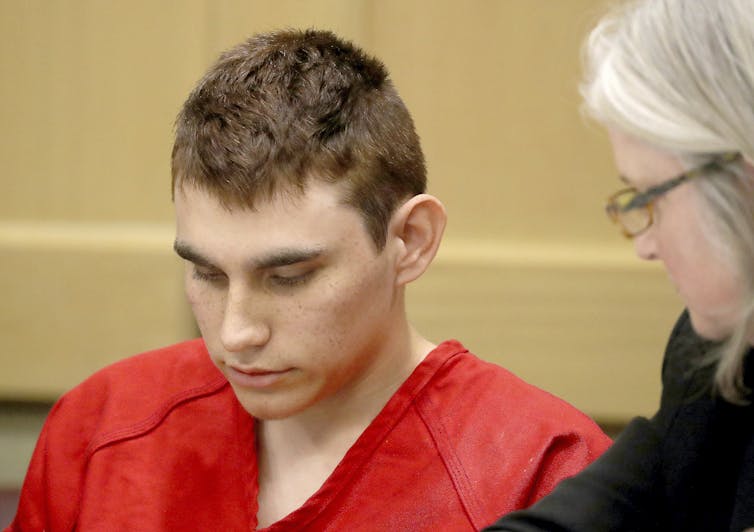

In the wake of mass shootings and other tragedies, a frequent refrain is: Why don’t we get those dangerous people off the streets? And, just as frequently, people suggest that mental health treatment is the answer.
Yet, for two main reasons, mental health treatment is not an easy solution to violence. The process of treating mental illness is difficult and complicated. More importantly, the vast majority of people with mental illnesses are not violent and the vast majority of lethal acts of violence are not perpetrated by people with mental illnesses.
I am a forensic psychologist and professor of psychology. I have studied mental illness, violence and mental health treatment at length. Here are some reasons that mental health treatment is not going to “cure” violence.
Identifying symptoms of mental illness
Recognizing that someone is experiencing mental health problems is a necessary first step to treatment. This requires that either someone recognizes and discloses his or her own symptoms of mental illness, or that others identify a person’s symptoms.


People may not want to come forward with their symptoms because of stigma and concerns that friends and others will view them as dangerous. They also may not recognize that they have a mental illness. Indeed, lack of insight or unawareness of symptoms is a feature of many serious mental illnesses, such as schizophrenia or bipolar disorder.
Alternatively, mental health and other professionals can use universal screening protocols to screen everyone in a given setting, such as a school, workplace or doctor’s office, for symptoms of mental illness. These are short questionnaires that survey a range of symptoms that may indicate the presence of mental illness.
A positive screen does not mean that someone has a mental illness, however. It means that he or she may be at risk. To be diagnosed after a positive screen, that person would have to receive an in-depth evaluation by a health care professional.
Routine screening requires a place of regular contact. Federal laws mandate that Medicaid-eligible children are screened for mental health conditions and recommend screening in schools more generally. The American Academy of Pediatrics also recommends routine screening of children and youth in primary care settings.
But many schools and primary care offices don’t conduct routine mental health screening. Even when they do, they are not equipped with the skills or resources to follow up with comprehensive mental health treatment.
Challenges to providing treatment
Providing mental health care is not necessarily a straightforward task. People with mental illnesses may not want to seek treatment, and family, friends or teachers can’t simply force them to go. People with mental illnesses also have the legal right to refuse treatment, except in severe cases.
In such cases, discussion typically turns to involuntary treatment. Every state has civil commitment laws that establish criteria for determining when involuntary treatment is appropriate.
Although the specific legal standards vary by state, these laws generally describe criteria relating to the physical danger a person presents to himself or herself or to others due to a mental illness. In other words, for someone to be treated against their will in a hospital or in the community, a mental health professional must determine that: a) the person is suffering from a serious mental illness; b) he or she presents a serious, typically physical, threat to himself, herself or others; and c) that the threat is due to the mental illness.
Civil commitment is a legal process. There are two key points here. First, if the threat to self or others cannot be attributed to serious mental illness, then involuntary treatment standards do not apply. Second, a caregiver cannot make this decision; it must be made by a court. People looking for solutions to violence should not overlook these points.
People with mental illnesses are as heterogeneous as those without when it comes to the causes and motives for violence. While some have symptoms that lead them to act violently, others have symptoms that are not relevant or even decrease their risk of violence.
And, while some mental health conditions are more clearly and strongly linked to violence, such as personality disorders and substance use disorders, these conditions would not typically meet involuntary treatment standards.
Long waits and limited resources
What happens when someone seeks mental health treatment voluntarily or is involuntarily committed? It depends. Our mental health services are overburdened and under-resourced. For example, we need somewhere between 40-60 beds per 100,000 people, but there are only about 11 beds per 100,000. Mental health settings across the United States have long wait lists and are under pressure to discharge patients quickly because of overcrowding, limitations on what insurance will cover, or lack of insurance altogether.
A recent report on barriers to outpatient mental health services in Massachusetts, for example, found that children, those who needed a psychiatrist, and adults covered by Medicaid were among those who waited the longest – often months. While waiting for treatment, symptoms may worsen. Untreated symptoms can result in acute mental health crises that lead to stays in hospital emergency departments or in jails, where their symptoms worsen.


In addition, while there are many treatments with demonstrated effectiveness, providers may be limited in terms of the services they can provide and bill for. For example, insurance may not cover certain types of treatment or may limit the number of treatment sessions. There also can be challenges to the implementation of evidence-based practices in mental health settings that reduce their availability. Many people with serious mental illnesses have publicly funded insurance, such as Medicaid, or are uninsured, further limiting their treatment options.
About one-third of those diagnosed with mental illness do not receive mental health services.
Treatment for mental illness isn’t going to lower rates of violence
If we were able to successfully treat people with serious mental illnesses, how would this change rates of violence in the United States?
Not much.
Although serious mental illnesses are associated with increased risk for violence, the rate of violent incidents in the United States that is attributable to mental illness is quite small – only about 3-5 percent. And, the rate of gun violence perpetrated by adults with mental illnesses is even lower – about 2 percent.
In fact, adults with mental illnesses are much more likely to be victims than the perpetrators of violence.
![]()
![]()
Sarah Desmarais, Professor of Psychology, North Carolina State University
This article was originally published on The Conversation.

